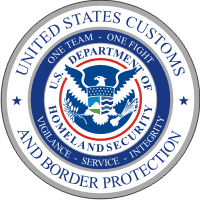US Customs and Border Protection - General Information
Appearance
| This article is part of the Customs Compliance Guide |

U.S. Customs and Border Protection (CBP) is the federal law enforcement agency responsible for customs services in the United States. As such, all individuals and all goods entering the United States must be authorized to do so by CBP at the first point of entry. Being familiar with CBP regulations and procedures is a must for highway carriers crossing the border, as non compliance can result in delays, penalties, seizures, and refused entry.
Requirements
- SCAC
- Standard Carrier Alpha Code. Motor carriers operating in the United States are required to maintain a SCAC. The National Motor Freight Traffic Association is responsible for issuing a SCAC to a carrier. The SCAC is then used to identify the carrier to CBP.
- Customs Clearance
- In order for goods to be allowed to enter the United States, they must either be customs cleared or authorized to move in bond. Customs clearance will usually require a formal entry under the PAPS process, but a variety of other shipment clearance types exist for exceptions. Moving goods in bond also requires a formal process.
- ACE eManifest
- Highway carriers bring commercial goods into the United States are required to transmit ACE eManifest data to CBP at least one hour prior to arriving at the border. Carriers can file ACE through a service provider, such as BorderConnect, or through the ACE Secure Data Portal.
Trusted Trader Programs
- C-TPAT
- Customs-Trade Partnership Against Terrorism. Program in which member carriers and importers agree to implement high security standards in exchange for being recognized by the CBP as low risk, which in the case of carriers can entail fewer CBP inspections. Carriers that are C-TPAT approved are automatically enrolled in the FAST program.
- FAST
- FAST, which stands for Free and Secure Trade, is a joint initiative between CBP and CBSA designed to enhance border security while speeding up the processing of low risk shipments. Carriers that are FAST approved for the U.S. are able to transport FAST shipments, and are afforded special processing at the border including dedicated lanes and front of line line processing in the case of inspections.
Glossary of Terms
ACE eManifest
- ACE
- Automated Commercial Environment. CBP system designed to facilitate legitimate trade and strengthen border security.
- Commodity Description
- Plain language description of the cargo sufficient to identify it for customs purposes.
- Commodity Quantity
- Count of total number of packages for the shipment.
- Commodity Weight
- Total gross weight of the goods for the shipment.
- Consignee
- For eManifest purposes this is the "delivery to party" from the contract of carriage that brings the goods to the United States. Additional distribution may take place after the fact but it is not the responsibility of the arriving carrier to report the ultimate consignee(s).
- eManifest
- Electronic document used by CBP to risk assess commercial goods bound for the United States based on information provided ahead of time by the carrier.
- Port of Arrival
- CBP port where the carrier is expected to arrive in the United States.
- Shipment
- Portion of an eManifest which specifies shipper, consignee, and commodity information. One manifest may include several shipments if multiple stops are involved. A shipment can be a PAPS or numerous other shipment types.
- Shipment Control Number
- A number that uniquely identifies a shipment to CBP. Consists of a carrier's SCAC, followed by a unique reference number assigned by the carrier. For PAPS shipments the Shipment Control Number is the PAPS Number.
- Shipper
- Party shipping the goods as stipulated on the bill of lading/shipping document.
- Trip Number
- Unique reference number given by the carrier to a manifest. Consists of a carrier's SCAC, followed by a unique number assigned by the carrier.
- Trip
- Portion of an eManifest which specifies which driver, truck and trailer will arrive in the United States as well as a complete list of all Shipments aboard. Carriers should only submit one trip for each time a truck crosses the border, making sure that it accounts for all freight.
General
- Carrier
- Owner or person in charge of a conveyance that is engaged in international commercial transportation of specified goods.
- Customs Broker
- Agent authorized to transact business with CBP on behalf on the importer of goods. The customs broker prepares formal entries which allow the goods to enter the United States, as well as accounting documents to handle any duties and taxes payable.
- Importer
- Party importing commercial goods into the United States. The importer is ultimately responsible for securing the release of the goods and the payment of duties and taxes, usually through the hiring of a customs broker.
- In Bond
- Goods that are authorized by CBP to move inland into the United States but have not been released are moving in bond. Bonds are most commonly used in transiting goods through the U.S. to another country.
- PAPS
- Pre-Arrival Processing System. Clearance option that involves having a formal entry for the clearance of commercial goods accepted by CBP prior to the arrival of the goods in the United States. PAPS is the default process for bringing commercial goods into the United States by truck and is mandatory unless otherwise exempt.
- Release
- Commercial goods that have met their import requirements for entry into the United States, passed or been waived from CBP examination, and have been authorized to move beyond CBP control are said to be released.
